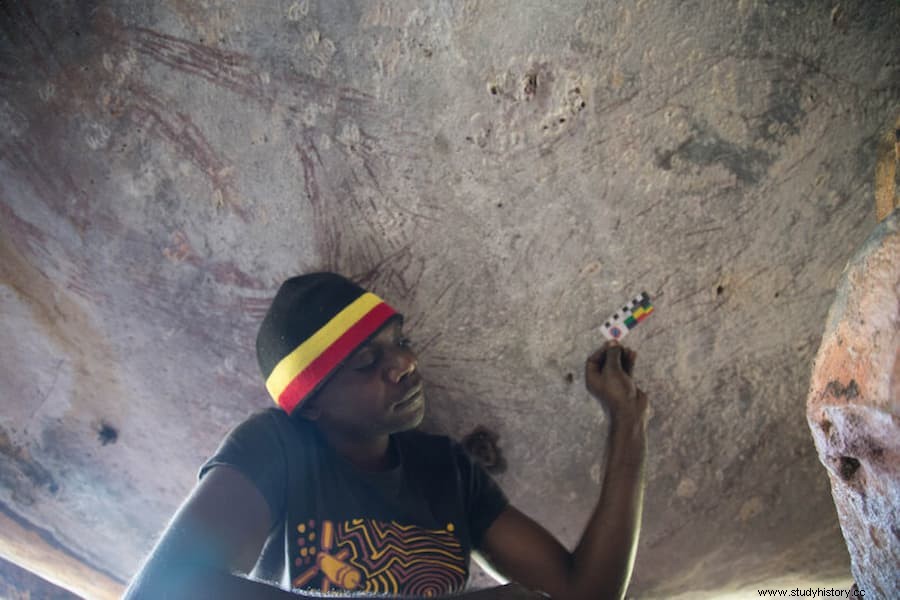A two meter long painting of a kangaroo in the Kimberley region of Western Australia has been identified as the oldest intact cave painting in Australia.
Using radiocarbon dating of 27 mud wasp nests, collected above and below 16 similar paintings, a University of Melbourne collaboration has dated the painting to between 17,500 and 17,100 years old.
This makes the painting Australia's oldest in situ said Dr. Damien Finch, a postdoctoral researcher who pioneered the new radiocarbon technique.
This is an important find, because thanks to these first estimates we can understand something of the world in which these ancient artists lived. We will never know what was in the artist's mind when he painted this work more than 600 generations ago, but we do know that the naturalistic period lasted until the last ice age, so the environment was colder and drier than today .
The Kimberley research is part of Australia's largest rock art dating project, led by Professor Andy Gleadow of the University of Melbourne. The Balanggarra Aboriginal Corporation, the universities of Western Australia, Wollongong and Manchester, the Australian National Science and Technology Organization and partners Rock Art Australia and Dunkeld Pastoral are participating.
Dr. Finch and his colleagues published in Nature Human Behavior an article detailing how the rock shelters have preserved the Kimberley rock painting galleries for millennia, many of which were repainted by later artists, and how they have managed to date the kangaroo rock painting as the oldest known cave painting in Australia site.
The kangaroo is painted on the sloping roof of a rock shelter on the Unghango clan estate in the Balanggarra region above the Drysdale River in the northeastern Kimberley region of Western Australia.

The first researchers looked at the stylistic features of the paintings and the order in which they were painted when they overlapped, and were able to deduce from this that the oldest style of painting is known as the irregular filler animal or naturalistic period, which is usually present life-size animals. This kangaroo is a typical example of paintings in this style.
Dr. Finch said it was rare to find mud wasp nests both above and below the same painting. In the case of this painting, they were able to take samples of both types to establish the minimum and maximum age of the work.
We radiocarbon dated three wasp nests underlying the painting and three nests built on top of it to determine with certainty that the painting is between 17,500 and 17,100 years old; most likely 17,300 years old .
Dr. Sven Ouzman, from the School of Social Sciences at the University of Western Australia and one of the lead researchers on the project, said the cave painting would provide a better understanding of indigenous cultural history.
This iconic image of the kangaroo is visually similar to cave paintings from the islands of Southeast Asia, dating back more than 40,000 years, suggesting a cultural link and hinting at even older rock art in Australia said Dr. Ouzman.
Cissy Gore-Birch, president of the Balanggarra Aboriginal Corporation, said the partnerships were important to integrate traditional knowledge with Western science, to preserve Australia's history and cultural identity.
It is important that indigenous knowledge and stories are not lost and continue to be shared for generations to come Gore-Birch said. The dating of this oldest known painting on an Australian rock shelter has great significance to Aboriginal people and Australians and is an important part of Australian history .
The next step for the researchers, who aim to develop a time scale for Aboriginal rock art in the Kimberley region, is to date other wasp nests that are in contact with this and other styles of Kimberley rock art to more precisely establish , when each artistic period began and ended.
Fonts
The University of Melbourne / Finch, D., Gleadow, A., Hergt, J. et al. Ages for Australia’s oldest rock paintings . Nat Hum Behav (2021). doi.org/10.1038/s41562-020-01041-0
